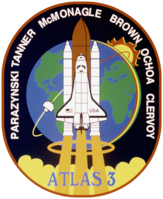STS-66
 | |
| Dane misji | |
| Indeks COSPAR | 1994-073A |
|---|---|
| Zaangażowani | |
| Oznaczenie kodowe | STS-66 |
| Pojazd | |
| Wahadłowiec | |
| Załoga | |
 Od lewej: Jean-François Clervoy, Scott Parazynski, Curtis Brown, Joseph Tanner, Donald McMonagle, Ellen Ochoa | |
| Dowódca | |
| Start | |
| Miejsce startu | |
| Początek misji | 3 listopada 1994 16:59:43 UTC |
| Orbita okołoziemska | |
| Apogeum | 310 km |
| Perygeum | 296 km |
| Okres orbitalny | 90,6 min |
| Inklinacja orbity | 57° |
| Lądowanie | |
| Miejsce lądowania | EAFB, Pas startowy 22 |
| Lądowanie | 14 listopada 1994 15:33:45 UTC |
| Czas trwania misji | 10 dni, 22 godz, 34 min, 2 sek[1] |
| Przebyta odległość | 7 330 226 km |
| Liczba okrążeń Ziemi | 174[1] |
| Program lotów wahadłowców | |
STS-66 (ang. Space Transportation System) – trzynasta misja wahadłowca kosmicznego Atlantis i sześćdziesiąta szósta programu lotów wahadłowców.
Załoga
- Donald McMonagle (3)*, dowódca (CDR)
- Curtis Brown (2), pilot (PLT)
- Ellen Ochoa (2), dowódca ładunku (MS1)
- Scott Parazynski, M.D. (1), specjalista misji (MS4)
- Joseph Tanner (1), specjalista misji (MS2)
- Jean-François Clervoy (1), specjalista misji (MS3) (ESA, Francja)
- *(liczba w nawiasie oznacza liczbę lotów odbytych przez każdego z astronautów)
Parametry misji
- Masa:
- startowa orbitera: - kg ?
- lądującego orbitera: - kg ?
- ładunku: 10 544 kg[1]
- Perygeum: 296 km[4]
- Apogeum: 310 km[4]
- Inklinacja: 57°[4]
- Okres orbitalny: 90,6 min[4]
Cel misji
Specyficzny typ misji promów to loty, w których z ładowni wahadłowca wypuszczano satelitę, by pod koniec misji ponownie go złapać i przywieźć na Ziemię. W ten sposób realizowano badania naukowe, wymagające oddalenia się od promu. Jego obecność mogła negatywnie wpływać na wyniki badań. Tego typu ładunki określano mianem free-flyer (swobodnie latający)[5].
Był to lot poświęcony badaniom atmosfery ziemskiej przy pomocy zestawu aparatury ATLAS-03 (Atmospheric Laboratory of Applications and Science). Ponadto umieszczono na orbicie, a po ośmiu dniach misji przechwycono satelitę CRISTA-SPAS również służącego do badań atmosfery[1][3]. Satelita CRISTA-SPAS (Cryogenic Infrared Spectometers & Telescopes for the Atmosphere) to platforma służąca do badań naukowych. Do jej wypuszczenia i złapania wystarczył manipulator wahadłowca. Spacery kosmiczne nie były już konieczne[5].
Zobacz też
Przypisy
- ↑ a b c d Mark Wade: STS-66 (ang.). W: Encyclopedia Astronautica [on-line]. [dostęp 2017-07-25].
- ↑ Robert Godwin: Space Shuttle. Warszawa: Prószyński Media Sp. z o.o., 2011, s. 71, seria: Historia podboju Kosmosu. ISBN 978-83-7648-973-5.
- ↑ a b Tomáš Přibyl: Dzień, w którym nie wróciła COLUMBIA. Bielsko-Biała: Wydawnictwo >DEBIT<, 2003, s. 169. ISBN 83-7167-224-1.
- ↑ a b c d STS 66 (ang.). W: NSSDCA Master Catalog [on-line]. NASA. [dostęp 2014-06-12]. [zarchiwizowane z tego adresu (2014-07-14)].
- ↑ a b Misje free-flyer. T. 108. Poznań: Amermedia Sp. z o.o., 2014, s. 21, seria: Kosmos. Tajemnice Wszechświata. Encyklopedia Astronomii i Astronautyki. ISBN 978-83-252-2324-3.
Linki zewnętrzne
- podsumowanie misji STS-66 na stronie KSC (ang.)
- Mark Wade: STS-66 (ang.). W: Encyclopedia Astronautica [on-line]. [dostęp 2017-07-25].
- Spaceflight mission report: STS-66 (ang.). Spacefacts. [dostęp 2017-07-25].
Media użyte na tej stronie
The flag of Navassa Island is simply the United States flag. It does not have a "local" flag or "unofficial" flag; it is an uninhabited island. The version with a profile view was based on Flags of the World and as a fictional design has no status warranting a place on any Wiki. It was made up by a random person with no connection to the island, it has never flown on the island, and it has never received any sort of recognition or validation by any authority. The person quoted on that page has no authority to bestow a flag, "unofficial" or otherwise, on the island.
STS-66 Mission Insignia
The crew assigned to the STS-66 mission included (left to right) Jean-Francois Clervoy, mission specialist; Scott E. Parazynski, mission specialist; Curtis L. Brown, pilot; Joseph R. Tanner, mission specialist; Donald R. McMonagle, commander; and Ellen S. Ochoa, payload commander. Launched aboard the Space Shuttle Atlantis on November 3, 1994 at 11:59:43 am (EST), the STS-66 mission's primary payloads were the Atmospheric Laboratory for Applications and Science-3 (ATLAS-3) and Cryogenic Infrared Spectrometers and Telescopes for the Atmosphere Shuttle Pallet Satellite (CRIST-SPAS).


